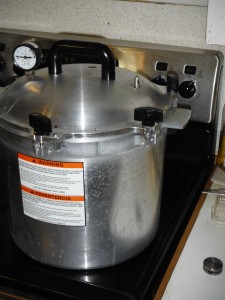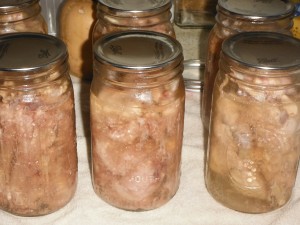I’ve had a VERY productive year raising my New Zealand/AlTex cross meat rabbits. Not that I should be surprised, they ARE rabbits. And since I’ve packed my tiny freezer full of rib eye steaks, I’m kind of low on available storage for animal protein. A perfect chance to try out the same method of preserving that I used on fish and chicken a while back, pressure canning.
The process is rather straightforward, though scary the first time through. A high-pressure device sits on your stove…with a fire under it. Nasty rumors are everywhere about pressure canners that exploded and killed someone’s neighbor’s great-aunt in another state fifty years ago…but you never hear a recent story, or one that can be proven. The reason for this is that pressure canning is SAFE. In this age of lawyers and litigation, no company is going to put out a product that can allow a untrained person to inflict harm upon themselves without REALLY trying. So even if you do NOT err on the side of caution and do NOT follow the exact methodology they prescribe when pressure canning…you’ll probably not blow anything up. And end up with a quality long-term storage product as well. However, I HIGHLY recommend you follow the instructions for your particular canner. Each is a little different, so has a different procedure. FOLLOW IT!
What canner do I use? Mine is an All-American 921 pressure canner, capable of holding 24 half-pints triple-stacked, 19 pint jars double-stacked or 7 quart jars in a single layer. Does it hold enough for my needs? What did Mel Tillis say in Cannonball run?
I do. And did. I read over both the processing guidelines in the Ball Blue Book and the All-American 921 pressure canner manual before each time I pressure can. The only thing I DO NOT follow in their safe practices guide is the fact that I use my canner on a glass top stove – something I deliberate on every time, but have done quite a bit of research, and have found many others that do so, and do it safely. The issue, it seems, with using the large canners on glass top stoves is the possibility of the weight breaking the glass top. I take my chances, since my only other option is to use a propane turkey fryer outside, something I have, but find rather cumbersome to use for this process. I DO miss cooking on stove powered by natural gas.
So, following proper procedures for the All-American 921 canner, I prepped it and followed the Ball Blue Book direction for “cold pack – squirrel, rabbit or poultry”.
(Quart jars + cut up rabbit) + (Ball Blue Book + All-American 921 canner) + time =
Tomorrow, we sample the end product. The smells was delicious! But my wife says it looks disgusting. What does she know, she thinks salad is food. Obviously salad is NOT food – it’s what food eats!
db



Thanks so much for these great rabbit primers. We also raise rabbits for meat, and usually freeze mine, but I’m interested in trying the canning. Do you brown yours first? Do you add water or broth? There are a number of suggested ways to can the rabbit…
Also, what do you use it for besides chili?
Excellent information here on your website, thanks!
Thanks for the kind words…
I use a raw pack method – exactly what is says, raw meat packed into cans. I add some water, about half filling the jars with water, though I’ve found that even without water, you get juices extracted.
As to what I do with it, anything I would do with any other canned meat, stews, soups, dips, spreads….a favorites is buffalo rabbit dip, look up any buffalo chicken dip recipe, and substitute rabbit in for the chicken.
Hope that helps…
db